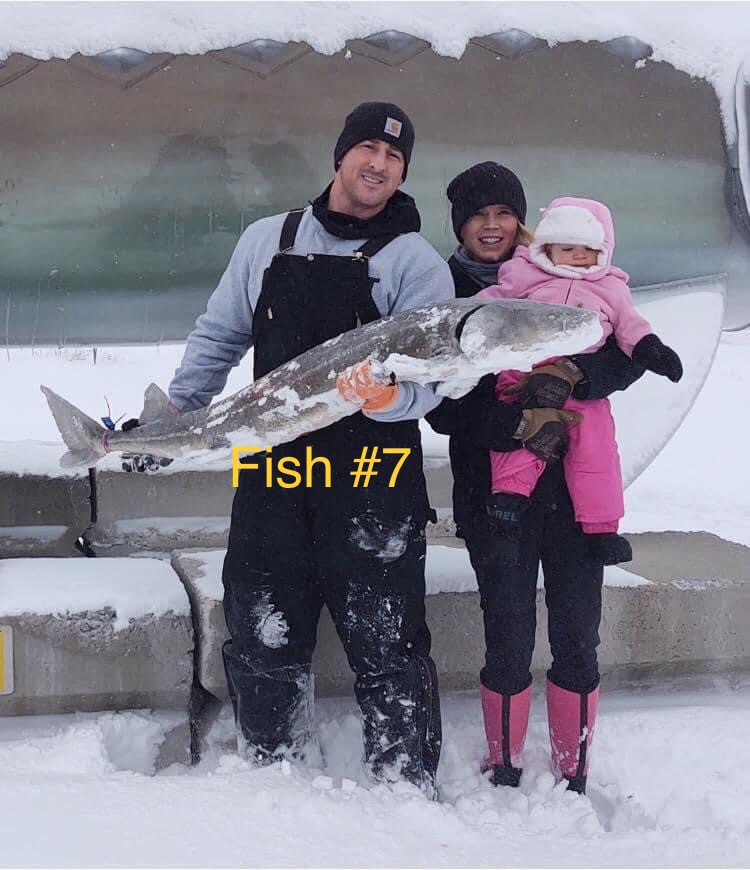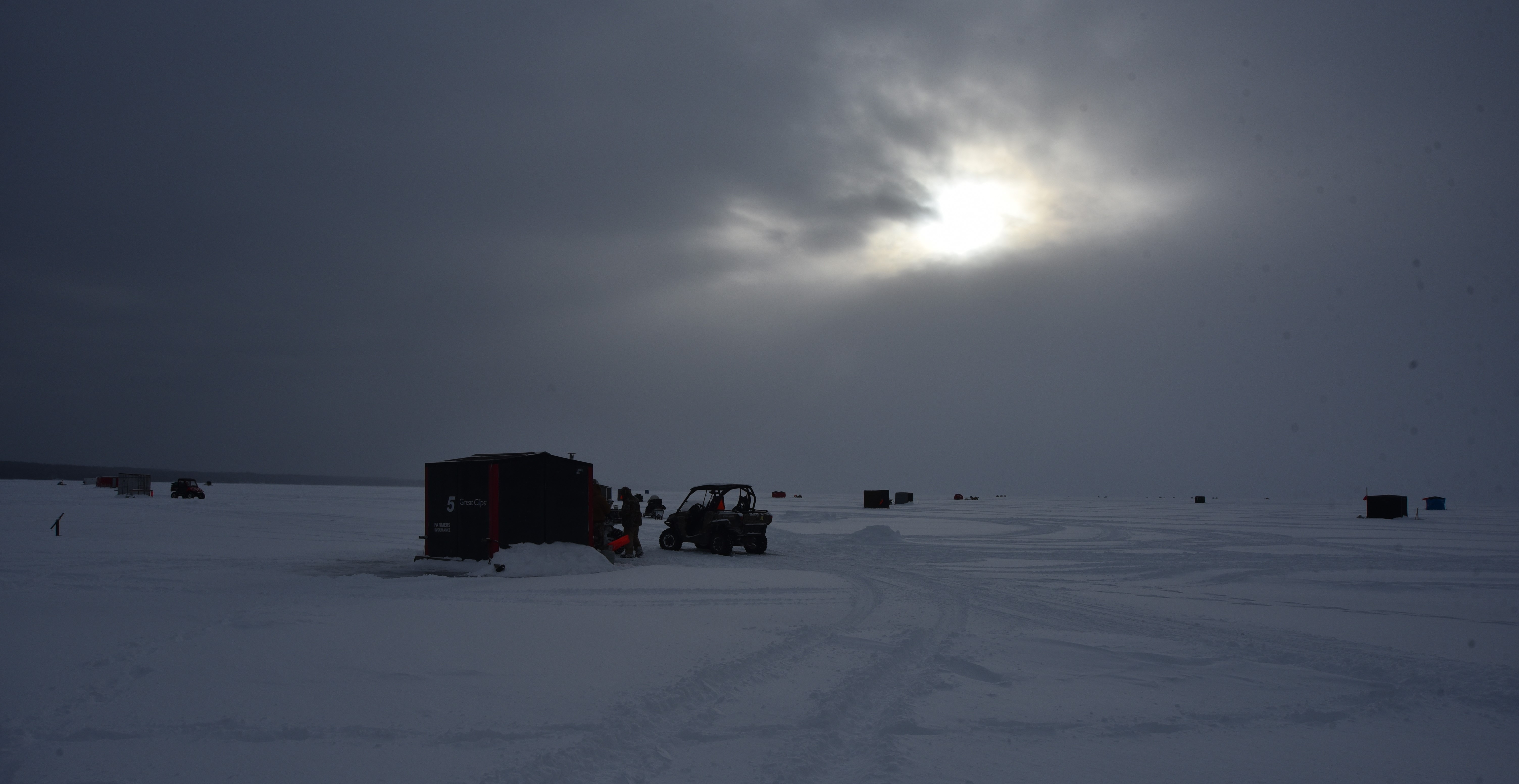
When Chris Wilson speared a 63-inch, 61-pound sturgeon, it was only moments after he lugged the fish out of his shanty before a small crowd appeared. Some trotted over from nearby shanties and one man rode up on an ATV – he wasn’t fishing but simply spending the morning checking out the season.
Michigan’s annual Black Lake sturgeon season began at 8 a.m. on Feb. 6, when 500-plus registered anglers hit the ice in hope of landing one of the revered, prehistoric fish.
Just two hours and six minutes later, with a group text message, it was over.
Inside a mix of commercial tent shanties and what might be described as homemade clubhouses, anglers sat anxiously awaiting a passing lake sturgeon below their holes in hopes of spearing one. And on Black Lake, it’s mostly just hopes.

A pair of Michigan DNR staffers hang out on the ice waiting for fish to be landed, Feb. 6, 2021. (Photo by James Proffitt)
The season ended when the sixth fish was caught, though a seventh was taken just moments later, before everyone received notification. And he Michigan Department of Natural Resources planned it that way, expecting the possibility of a last-minute catch based on a harvest rate of 1.2%.
“Since the fishing communities are in clusters, we kind of have DNR personnel embedded on snow machines in those areas,” said Tim Cwalinski, senior fisheries biologist with the MDNR. “So we know right away when one gets harvested. There’s a lot of radio contact with our headquarters. And since every angler gives us their cellphone number, we can send updates to every angler.”
The DNR estimated about a thousand adult sturgeon. The harvest rate of 1.2% has been in place for the past 10 years, according to Cwalinski.

The seventh and final fish of the 2021 sturgeon spearing season, speared by local resident Andrew LaLonde. The fish was a 60-inch female weighing 43 pounds and had been captured and tagged 15 years earlier. (Photo provided by Michigan Department of Natural Resources)
“That works out to 12 fish,” he said. “The state’s recreational anglers get six fish, and the Native American tribes get six fish.”
Lt. James Gorno, with the MDNR, said he’ll usually have about 15 to 20 people on the ice spread out to oversee the fishing. They work mostly in pairs riding snowmobiles.
“A mixture of law enforcement and fisheries personnel will be monitoring the spearing. Our main goal is to make sure it’s not over-fished, no extra fish being speared,” he said. “It’s a very controlled season, very managed.”
While state personnel are on the ice they listen for updates on the radio, which give information about where a fish was taken. Officials immediately go to the site, inspecting and tagging the fish, then updating on the radio.
“The holes are large, the size of a desk at least. They’ll spear a fish and pull it up slowly and securely to the hole, then grab it and then outside onto the ice,” Gorno explained. “When someone spears one everyone knows.”
An ancient population gets new life
Lake sturgeon have been around for more than 130 million years, remaining unchanged since the time dinosaurs roamed what is now Michigan. The fish can grow to lengths of more than 7 feet and weights of 240 pounds or more. Females can live more than 150 years.
While the fish is now listed as threatened or endangered in 19 of the 20 states within its native area – which includes the Mississippi River, Hudson Bay and Great Lakes basins – it was once so plentiful that commercial anglers pulled them from nets and stacked them on beaches to prevent them from fouling their fishing gear.
After commercial exploitation began in the second half of the 19th century, they were nearly fished out of existence in the Great Lakes. In 1885, 8.6 million pounds of sturgeon were harvested, with about 60% taken from Lake Erie. Overfishing, habitat loss, dams and pollution are all credited in the big fish’s demise.
In 1997, fisheries biologists noticed a serious decline in the populations of sturgeon in Black Lake and other lakes and streams in the Cheboygan River watershed. Since then, efforts to bring the sturgeon back have been met with success.

The largest sturgeon in the Cheboygan River watershed is this one in Onaway, about 50 feet in length. (Photo by James Proffitt)
“We’ve been stocking, and we see a lot of wild production of sturgeon in the Black River,” Cwalinski said. “For years we’ve been documenting sturgeon where they spawn, and there’s always good natural reproduction. The problem is survival rates.”
Because of that, MDNR staff harvest tiny sturgeon fry from the river and raise them in a streamside hatchery until they’re about 5 or 6 inches, then stock them in late summer. He described it as a Head Start program for sturgeon, ensuring that greater numbers will survive.
But the MDNR staff aren’t alone in the sturgeon-saving game. Scientists with Native American tribes including Bay Mills Indian Community, Little River Band of Ottawa Indians, Little Traverse Bay Band of Odawa Indians, Grand Traverse Band of Ottawa and Chippewa Indians and the Sault. Ste. Marie Tribe of Chippewa Indians also manage fisheries, as well as Michigan State University and the Black Lake Chapter of Sturgeon for Tomorrow.
While the Black Lake (which covers 10,000-plus acres) population was estimated to be well over 1,500 fish at one time, by 1997 it was believed to be only several hundred. Nearby Mullet and Burt Lakes, which had historically supported a sturgeon spearing season, had theirs cancelled by the MDNR. And Black Lake’s season narrowly escaped the same fate before Michiganders stepped up to the conservation plate.
Sturgeon for Tomorrow solving problems today
In 1999 Brenda Archambo founded the Black Lake Chapter of Sturgeon for Tomorrow (BLC), a nonprofit aiming to ensure the future sturgeon population.
Their to-do list included making sure a sturgeon spearing season on Black Lake continued, helping increase the sturgeon population through education and awareness and raising money to help fund sturgeon-related projects.
“Both my family and my husband’s family are fourth-generation sturgeon fishermen. In 1995 is when I read an article the state was going to update the sturgeon management plan and that’s when I got involved,” Archambo explained as we sat in her roomy, stick-built ice shanty just after the close of the season. “We started BLC initially to protect the sturgeon in the spring when they were spawning and vulnerable and people were poaching them.”

Brenda Archambo looks fondly on old sturgeon fishing photos from her family’s long Black Lake history. (Photo by James Proffitt)
The Sturgeon Guarding program dispatches people to the banks of streams where sturgeon, in their quest to spawn, give up the safety of deeper lake waters to frolic in the shallows. There, Archambo said, it was common practice for poachers to harvest fish, including the taking of eggs to sell as caviar. In many cases it was as simple as wading into the water and grabbing one by the tail.
From there BLC activities naturally expanded to include netting and tagging fish, larval sampling, hatchery operations and a Sturgeon in the Classroom program where schools foster sturgeon in aquariums for eventual release.
“Over the years the program went from the sportsmen wanting to save their sport by going out on the rivers in the spring to protect them so their numbers would stay up, to a recovery program, education and outreach, and that’s how we got involved,” Archambo said. “I think the big thing in terms of the whole process is educating people about sturgeon, how they’re so majestic and why they’re important. We have them here, it’s not like they’re everywhere so it’s very important in terms of being a natural resource. It’s kind of like mining gold, you just have to learn how to mine it. And not for pilfering, but for a natural resource.”
But efforts surrounding the Black Lake population and fish in the Cheboygan River don’t end there. BLC and its conservation partners like to spread the wealth, working cooperatively to rear young sturgeon which they use to populate Mullett and Burt lakes, as well as five rivers in the Saginaw Bay watershed.
Archambo said public interest in sturgeon has blossomed since BLC’s founding, especially with the guarding.
“We’re an all-inclusive group; anyone can come. We usually recruit about 400 people each spring. It’s enforcement, but it’s also camaraderie, coming out to see spring come alive. Camping along the river, a lot of people canoe or kayak,” she said, going on to admit the poaching issue has mostly been put to rest due to enforcement spawned by the spring river outings. “When things are crazy in the world and there’s unrest, there’s still a place you can go in the wilderness and be alone with your thoughts. It’s nature therapy and it’s good for your soul.”

Snow moving in on Black Lake Feb. 6, 2021. (Photo by James Proffitt)
Black Lake spearing season contributes to conservation
Archambo said the Black Lake population, including the taking of a small number of fish each year, has long been a part of the region’s outdoors heritage. And the opportunity to try for one each winter pays off with a collective sense of stewardship and advocacy. Case in point: her family. While Archambo hasn’t speared for sturgeon in years, she spent the brief season with two siblings, who both fished this year.
“I’m here because we wanted to get a sturgeon, but we didn’t see any,” Brenda’s sister Kathy lamented. Though she’s fished many times over the years, Kathy’s yet to spear a sturgeon – though it doesn’t keep her from trying. “You just don’t get a chance to do something like this very often.”
As we sat and talked for about 30 minutes after the season ended, a long, dark form glided slowly across the bottom, about 17 feet below – a sturgeon about 50-inches long. Too late to spear, but just in time to offer up a view of a cool fish in a cool place alongside a sense of benevolent satisfaction. Despite the fact it was too late for Kathy to take a shot at it, the sight of the big fish made both ladies very happy.
“It’s bittersweet to see a dead sturgeon on the ice,” Archambo said. “My first thought is ‘Is it one we’ve tagged in the river?’ Of course, they’ll know that when the fish is registered, they’ll take the length, weight, girth and gender and they’ll also take a fin clip for genetics purposes.”
BLC and MDNR keep tabs on fish by tagging those they come into contact with in the shallows during spawning. This allows long-term monitoring of the population.
While Michiganders persevere in bringing populations up, other states including Ohio and Wisconsin also work cooperatively to raise and stock fish.
Big fish party cancelled this year, but will return
The Black Lake Sturgeon Shivaree is a little party on the ice with a couple thousand of the region’s closest friends and new ones every year, which features food, music and activities. It was held last year just before COVID-19 turned into a worldwide pandemic but was cancelled this year.
“We were probably spreading it last year at the Shivaree but we just didn’t know it yet,” Kathy said. “We had a big tent with a lot of people packed in it dancing and having a good time.”
Despite the absence of the Shivaree, which is BLC’s signature event, the 2021 Black Lake season is all good, Archambo assured.
“You know, we might be in the midst of a pandemic and it’s been almost a year, but the excitement and camaraderie with the sturgeon fishing and the cultural significance of that is still alive and well,” she said. “During a normal year we would have a fishing contest and a poker run that goes to five different businesses. That’s one of our biggest fundraisers. But whatcha’ going to do? We’re just going with the flow. I haven’t been in a shanty for 10 years, so this was a great year after all.”

The Archambo Condo. (Photo by James Proffitt)
So with family, in a propane-heated shanty with lights (courtesy of a battery and inverter) the two sisters described it as another successful season.
“We call it The Condo. It’s quite nice, isn’t it? It’s warm and toasty, and it’s like you’re looking down into an aquarium,” Archambo said.
Pulling up a traditional red and white hookless fish decoy about 12 inches long, Archambo explained she was holding a coaxer.

Photos inside Archambo’s on-the-ice headquarters tell the story of four generations of winter sturgeon spearing. (Photo by James Proffitt)
“There are other fish in here, like muskie and pike. Depending on how big it is we would probably take a chance on that,” she said. “Sturgeon are bottom feeders, and so they glide along the bottom sucking up insects and crayfish larvae. They’ll come up to the decoys to check it out because they’re curious fish.”
In addition to a coffee pot and snacks, the shanty boasts food for the soul: ice fishing photos of decades past and physical connections to family history.
“See, the thing is, this is my grandfather’s spear,” Archambo said, picking up a long-handled pitchfork-style sturgeon catcher with nine barbed tines coated with green iridescent paint. Motioning to the other end of their seven-foot rectangular hole, she added, “and that’s my brother’s spear. Both of them have passed on.”
Kathy said it would please both to know their spears are being used.
“They’re with us in spirit,” she said. “They would be proud of us.”
Catch more news on Great Lakes Now:
On Michigan’s inland lakes, ice fishing with less ice, and fewer fish
PFAS is in fish and wildlife. Researchers prowl Michigan for clues.
Fisheries Fight: Michigan commercial fishers bring MDNR rules to court
Family-owned fishing businesses displaced by waterfront developments on Great Lakes
Fall Brawl: Sheffield Lake fishing derby inspires intense angling
API key not valid. Please pass a valid API key.Featured image: Chris Wilson’s 63-inch sturgeon moments after it was pulled from the water, Feb. 6, 2021. (Photo by James Proffitt)




